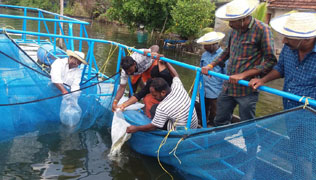 The coastal aquaculture in Kerala is set to get a major boost, as the ICAR-Central Marine Fisheries Research Institute (CMFRI), Kochi is popularising the cage fish farming model among the farming and non-farming communities across the State. The less expensive farming model will help to increase the aquaculture production.
The coastal aquaculture in Kerala is set to get a major boost, as the ICAR-Central Marine Fisheries Research Institute (CMFRI), Kochi is popularising the cage fish farming model among the farming and non-farming communities across the State. The less expensive farming model will help to increase the aquaculture production.
ICAR-CMFRI conducted cage farming of commercially important fish varieties suitable to the Kerala waters Kochi during 16th and 17th March.
The training was part of a continuous process the institute has been providing to those interested in the less expensive farming model under the All India Network Project on Mariculture (AINP-M) across the country. In Kerala, the ICAR-CMFRI provided technical support to those interested in the cage culture to equip them launch the farming by giving guidance on areas such as cage fabrication and installation, site identification, seed selection, feed management and trading. The training is aimed at helping the people to become successful entrepreneurs in cage fish farming.
Fifty people from seven districts in the State participated in the training programme.
Impact of Training
Soon after the training, the participants launched the cage farming of fish varieties such as pearl spot, seabass, red snapper, tilapia and giant trevally in the brackish and fresh water bodies in their respective regions. It is noteworthy that by 31st March 2017, around 40 farmers turned into cage farming venture, laying a solid base for ushering in ‘fish revolution’ in the State.
Cost effective technology
According to ICAR-CMFRI’s technology, cages made of GI pipes with a dimension of 4m X 4m X 3m (length, breadth and depth and a volume of 48 cubic metre) is suitable for farming in Kerala waters. The depth of the cage may vary depending on the depth of the water body. Seabass and pearl spot could be cultured in same cage simultaneously. Around ₹ one lakh is adequate for installing the cage and stocking seeds of seabass and pearl spot in a cage, in addition to the fresh feed cost which requires another ₹ 60,000 for a cage. About 1000 numbers each seabass and pearl spot seeds could be stocked in a cage of this size. After six months, seabass is expected to attain weight of 700 g to 1.2 kg and pearl spot 200 to 250 g depending on the stocking size of the seeds (about 50 g). An average 700 kg of seabass and 250 kg of pearl spot could be harvested from one cage itself within six to seven months of culture with a survival rate of 90 per cent. The farmer will get around ₹ 650 for a kilo of seabass and ₹ 550 for pearl spot in market.
(Source: ICAR-CMFRI)







फेसबुक पर लाइक करें
यूट्यूब पर सदस्यता लें
X पर फॉलो करना X
इंस्टाग्राम पर लाइक करें